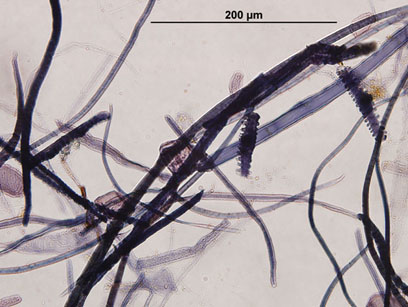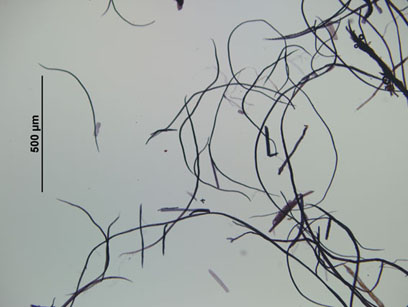Rice
| Common Name | Rice | Japanese Name | Kome/Wara |
|---|---|---|---|
| Scientific Name | Gramineae Orzya Sativa | ||
| Fibre Length | Average 1.5mm (0.5-3mm) |
Fibre Width | Average 10µm (5-15µm) |
| Fibre Ends | Pointed | Cross-Marking | None |
| Associated Cells | Parenchyma, Pitted Vessel Elements, Epidermal Cells, Prickle Hairs | ||
| Herzberg Colour | Blue | Graff 'C' Colour | Blue |
Notes:
Fibres are short, narrow, thick walled and have pointed ends. Pitted vessel elements are also present, although they are generally smaller and thinner than those in bamboo. Parenchyma cells are small barrel like, thin walled and abundant in pulp. Rice straw can be distinguished from other papermaking grasses by the presence of saw-toothed epidermal cells which are abundant (See Image 1). Silica bodies present in the form of phytoliths, and prickle hairs are also occaisonally present [14].
Readily abundant as a by product of agriculture it is commonly added to the pulp in China and Japan. Rice straw is often added to longer bast fibred pulp, such as Kozo, to soften the edges of the bleeding of ink for Calligraphy papers.
Traditional Processing of Rice Straw
After the seed is removed from the rice, the stalks are layered with lime and left to ret for six months. After this time the fibres are placed in fine mesh bags an suspended from poles in flowing water to remove much of the lime [19].
| Image 1 | Image 2 |
|---|---|
 |
 |
For information about this page, contact: Travis Taylor
Contact email address: travtora@gmail.com
Centre homepage: www.culturalconservation.unimelb.edu.au
Page last modified:
This page, its contents and style, are the responsibility of the author and do not represent the views, policies or opinions of The University of Melbourne.